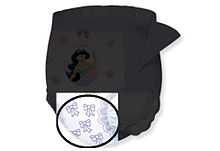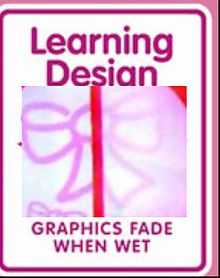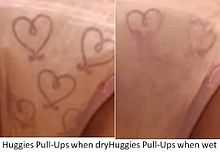Training pants
A training pant is an aid for toilet training, which is much like a traditional disposable diaper. Nowadays many brands are making toilet training pants since the success of Huggies Pull-Ups.
Commonly used features
These are features that are commonly used in toilet training pants. Most of these ideas were originated by Huggies Pull-Ups.
Flexible sides
Many toilet training pants use flexible sides for the wearer to easily pull them off and on like normal underwear. This is to increase independence, make training easier, and are designed to be child-friendly, as well as to make them designed like normal underwear, unlike most traditional diapers in which the diaper is fastened by cheap velcro straps which are unadjustable. Also unlike normal diapers, the sides are fastened from the get go right out of the box to make it easier for kids to put them on without help. In addition, some companies also use strong velcro on the sides. This keeps the pant as it normally is in terms of flexible sides, but also uses the velcro to detach by a parent if there ever was a case in which the child messes the pant excessively, so you can change and dispose of like a normal diaper. However, a negative effect played by the addition of this is the fact that the sides are more likely to break on certain occasions (for example, if it is a child with thicker legs). In addition at times pulls ups could negatively affect the child making them think they are still in diapers.
Leak guards
In addition, all training pants have leak protection for when the wearer wets the pant. When the pant is wet, the urine is absorbed and drawn into a compartment that absorbs the wetness, much like a diaper. This is used to prevent the wetness to ruin any clothing surrounding it, and also for privacy. However, if too much urine is absorbed, it can break open, exposing the foam that absorbs the urine. Many companies have allowed a fairly large amount of absorbency in their pants, mainly to make them appropriate to be used for night trainers who wet the bed.
Wetness indicator
In many cases, a training pant will contain a wetness indicator.



This is a set of designs printed in special ink that evaporates from liquid that is absorbed from the wearer-specifically urine, near the area that is most commonly urinated. When the child does wet the pant, these designs smudge to the point that they fade completely to white. This is intended to be an incentive for staying dry and a way to discourage wetting, and to identify when he or she is wet. This has been introduced in 2000, when first used by Huggies Pull-Ups.
Wetness Lining
In addition to the visual wetness indicator, some companies have gone as far as to introduce a liner inside their training pants, specifically in the area most frequently urinated. that reacts to wetness. This liner is intended to make the wearer feel discomfort or cold when he or she wets the training pants to a certain point, urging him or her to make a better effort to go to the toilet instead of urinate the pant. Pampers was the first one to use this feature with their Feel 'N Learn trainers, which were based specifically around the use of the wetness liner. This product and most other wetness liner products are now discontinued, likely due to lack of consumer interest. Also, just about all companies that use this feature also use the wetness indicator on their training pants. When Huggies used this feature on their Pull-Ups, they claimed that the wetness indicator is best suited for those who are visual learners, while the wetness liners are for those who learn from feeling.
Licensed characters
Many training pants depict licensed characters that are likely to be recognized by young children.
For example, Huggies has used the Disney Princesses, Toy Story, and Cars designs on their training pants. Pampers has used Dora the Explorer, and Go Diego Go! on their Easy Ups. The used of licensed characters on training pants is generally used to motivate the wearer and make wearing the training pants more interesting.
Currently, in 2014, Characters like Jake and the Neverland Pirates and Dora the Explorer are being used to attract kids to the "fun" of changing to big kid pants.
Designs on pants
Huggies uses a system for the designs on their pants. Learning Designs illustrations do not follow any system, but the Cool Alert designs always reflect wintertime, snow, ice, etc., and the Night-Time pants always reflect night time and dreaming. On Pamper's Easy Ups, the designs show Dora and Diego in illustrations that reflect their activities that would be similar to that in the TV shows Dora the Explorer and Go Diego Go!. This also applies to most other companies using licensed characters.
Influences
Pull-Ups frequently sets features on their products that are imitated the most by other companies.
Controversies
Training pants have had some controversial issues in the past-Mainly regarding the wetness liner being linked to rashes, as well as if it is actually effective in terms of impact.
Effectiveness of wetness liner
Many reviewers and parents have criticized the wetness liner on some training pants-Particularly Pamper's Easy Ups/Feel 'N learn, and Huggies's Cool-Alert Pull-Ups. These people have claimed that the wetness liner is the reason that their children have gotten rashes in genitalia area. This is likely due to a content being used in the liner that some individuals are allergic to.
Others have also claimed that while no allergic reactions take place, the wetness liner does not signal the child that he or she is wet, and/or does nothing.
Impact of the training pants
Some people have also questioned whether the training pants do any impact on the child's ability to use the toilet. Some people have claimed that it is about as effective as a generic diaper on their children, as some have reported that their child is not getting the difference between wet and dry—one of the main purposes of training pants nowadays.
See also
- Diaper
- Huggies Pull-Ups
- Pampers Easy Ups